Anglo-French rivalry in India. Battle of Plessis
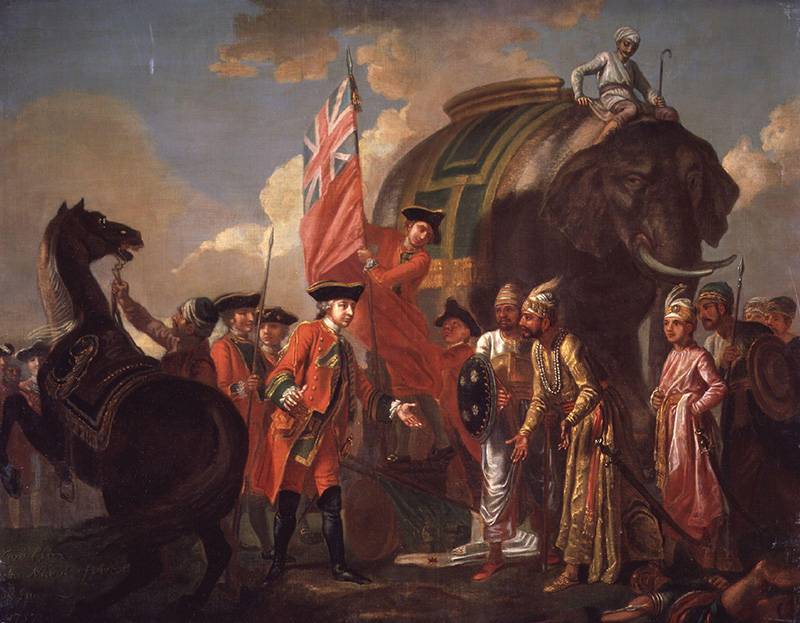
The Seven Years' War, many historians consider the first truly global. Unlike conflicts due to all sorts of “legacies,” in the events of 1756 – 1763. almost all major political players took part. The fighting took place not only on the fields of Europe that were generously fertilized with human blood, where soldiers in colorful uniforms with bullets and bayonets proved the right of their monarch to a piece of worldly glory, but also touched overseas lands. Kings became crowded in the Old World, and now they are excitedly sharing colonies. This process seized not only troops with a small number of settlers and local administration officials, but also the local population. The Indians of Canada, the multinational inhabitants of Hindustan, the natives of distant archipelagoes were involved in the game of the “great white gentlemen,” for whom they were even cheaper and readily released into the wind with consumables than their own subjects.
England and France used the new war to continue their uncompromising dispute. Misty Albion from the time of the confrontation with the skilled and wealthy Dutchmen has significantly strengthened, has acquired a powerful fleet and colonies. The theme of leisurely conversations by the fireplace was the confrontation between Prince Rupert and de Ruyter, overgrown with legends and fables, the campaigns of Drake and Reilly. The XNUMXth century was a time of struggle with a new rival, no less proud islanders thirsting for gold and glory. During the Seven Years' War, prim London and the glorious Versailles challenged each other's right to rule in North America and India. And Europe, shrouded in powder smoke, where Frederick II battalions hired for English gold marched under the squeak of a flute player and a measured rumble of drums, was only a backdrop for the unfolding colonial struggle.
France began to show interest in distant and exotic India already in the XVI century. At the time of Francis I, merchants from Rouen equipped two ships to go to eastern countries. They left Le Havre to disappear without a trace. Then France raged Huguenot wars, and there was no time for overseas trade. The penetration of regions rich in spices and other high-value goods acquired a more organized character in the era of Cardinal Richelieu. Under his auspices, a French East India Company was created, which, like the English and Dutch structures, was to concentrate in its hands trade with the East. However, the Fronda embarked on the path to the development of colonial expansion, and the company's public funding ceased. It was only when the tremors of domestic shocks subsided that France was able to focus on distant countries.
Now the main inspiration and mover of eastern and all overseas expansion in general was the right hand of Louis XIV, the actual head of government, Jean Baptiste Colbert, whose services to the kingdom of Golden Lilies are difficult to overestimate. He reorganized the miserable existence of the East India Company into a new corporation called the East Indies Company. Exotic spices and other goods already flowed to Europe, turning into densely stuffed golden chests. France, like the neighboring states, had to take an active part in such a profitable business. Colbert was a master of persuasion and a man of strategic intelligence, which greatly helped in the collection and concentration of start-up capital - Louis XIV donated X million Livres to 3. Large deposits carried grandee and merchants. In 1664, the company was finally founded at the state level with a capital of 8 million livres. She was granted broad rights and powers, including a monopoly permission to trade east of the Cape of Good Hope. The first president of the new company was Colbert himself.
Although France was clearly late for the start in trade with the East, the new enterprise began to develop rapidly, receiving support directly from the court. Already in 1667, the first expedition commanded by François Caron was sent to India, which in 1668 managed to achieve the goal and establish the first French trading post on the Indian subcontinent in the Surat region. In the following years, the number of strongholds in India has steadily increased. In 1674, the company managed to obtain from the Sultan Bijapur the territory on which the largest colony was founded - Pondicherry. Soon it was she who became the de facto administrative center of all the French colonies in India, intercepting the baton from Surat. In Pondicherry, along with a huge market, handicraft and weaving workshops functioned with might and main. By the end of the 17th century, France had a fairly large number of enclaves in this region, but all of them were scattered over a large area and therefore were autonomous.
However, it soon became clear that the stable trading and financial existence of French India had lost its position of “quiet business”. And the problem was not with the local warring and intriguing sultans, rajahs, native princes, and other middle and lower managers. The French were not the only white people in India. Having started their colonial marathon half a century earlier, England and Holland have already firmly established their roots in this eastern country. It is not idle tourism pushed the Amsterdam and London businessmen to master the way to the Indian Ocean, in whose considerable area was already closely and these respectable gentlemen. Therefore, the emergence of new people who want to bite off generously seasoned with spices, stuffed with Indian goods that were scarce in Europe, was perceived by the British and the Dutch without any signs of enthusiasm. The trading companies of these countries, which are the state in the state, were involved in a stubborn and uncompromising struggle, unceremoniously jostled with their elbows and, without much hesitation, used their fists. Good in Europe, they floated not less willingly. Already in August, 1693, during the war of the Augsburg League, Pondicherry was besieged by the Dutch and was forced to capitulate after a two-week siege. Under the terms of the peace of France, it was returned to India’s largest enclave in India, and soon it flourished again.
Active confrontation unfolded in the local lands and waters during the war for the Austrian inheritance 1744 – 1748. By the beginning of the conflict, the French had in the Indian Ocean a strong squadron of ten ships, but could not take advantage. The French East India Company generously concluded a truce with British colleagues, they say, there is a war in Europe, and we have a business. The British readily agreed, knowing of the imminent arrival of reinforcements from the metropolis. The armistice in the text emphasized that it applies only to ships and armed contingents of the British company, but not to government forces. In 1745, an English squadron arrived in the Indian Ocean, which began to hunt the French merchant ships. “Business partners” feignedly expressed sympathy and were indignantly restrained, while shrugging their shoulders: it’s not we, but the government that doesn’t understand the subtleties of business relations. Bertran de La Bourdonnay, the governor of the French island Ile-de-France (Mauritius), who had a ship formation at his disposal, finally spat on a lime tree and became an absolutely formal truce and landed a landing party at Madras, which the British owned, in September. The siege lasted five days, after which the British enclave capitulated. Instead of destroying Madras by inflicting a crushing blow on English trade in India, or completely driving the enlightened seafarers out of the city and making it already a French colony, La Bourdonné limited itself to ransoming £ million in money and 1746 million in goods. Soon the French squadron affected by the storm returned to Europe. The governor of French India, Joseph Duplex, reasonably considered the actions of La Bourdonnay insufficient and, taking Madras, began to strengthen it. The Peace of Aachen, signed in 9, returned the status quo to the borders of property - the city was returned in exchange for the fortress of Louisburg in Canada. The British East India Company continued to strengthen on the peninsula, while the resources of the French were very limited.
New Colbera was not and was not foreseen, Louis XV spent time in hunts, balls and carefree communication with metressami. In a businesslike manner, the favorite of King Madame Pompadour disposed of at court. With the external radiance and brilliance of France hirela, and with it melted and her colonial empire.
Arcot conflict
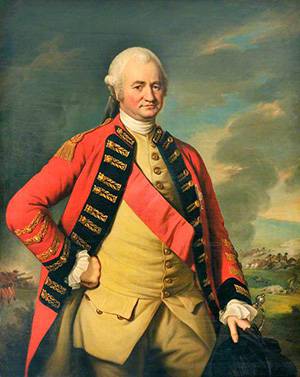
The strengthened British East India Company expanded its sphere of influence. The guns of the Seven Years' War had not yet been thundered in Europe, but far from it, the rival parties had already crossed their swords in the open. In 1751, the French decided to actively intervene in the struggle of the native groups for power. This was the time of the next and quite frequent in the local lands of a get-together, when two nabobs fought for power in the south-west of Hindustan. In the summer of 1751, the Marquis Charles de Bussy, having about 2 thousands of warriors — armed with natives and a small French contingent — spoke to help Chande Sahib, the “correct party candidate,” who laid siege to his pro-English Mohammed Ali in Trichinopoli. The annexation of the French detachment would bring the number of Sahib's army to 10 thousand people and would sharply increase its chances of success. This factor would have serious consequences for the position of the British East India Company, and the role of a mere observer obviously did not suit her.
From the British Fort St. David, located south of Pondicherry on the shores of the Bay of Bengal, came an armed detachment with supplies for his Indian protégé. The squad included a young man named Robert Clive. About this gentleman, whose closest descendants, inspired by the works of Kipling, "will bear a heavy burden" wild and not very hordes, you should say a few words. Mr. Clive began his career at the East India Company as a simple office clerk. Born in 1725, the 18 year old was sent to India. In 1746, he volunteered for the forces of the East India Company and took part in hostilities against the French. When the air again smelled distinctly of a mixture of gunpowder and steel, he again entered military service in 1751. Clive had the reputation of being a man of anger and aggravated with outbursts - a quiet clerical life with a study of the depth of the inkwell attracted him much less than hikes through the tropical jungle. Having overcome several hundred kilometers of difficult terrain, the detachment managed to reach Trichinopoli. At the site it turned out that the position of the local garrison, which has no more than 1600 people, leaves much to be desired. Clive was instructed to return to St. David and report on the disastrous state of affairs. An indefatigable Englishman makes a return march and returns successfully to the fort.
Clive proposed to the governor a plan for overcoming the crisis. Instead of wading again through the jungle to Trichinopoli, located deep in the territory, the best option was to strike the immediate possessions of Chandy Sahib - the city of Arkot, almost a hundred kilometers from Madras. Clive's plan was approved, and almost 300 European soldiers and 300 sepoys came under his command. The detachment had three field implements. 1 September 1751 The British approached Arcot, but only to find that the local authorities, along with the garrison, had fled. Above the new palace of Chanda Sahib, Mohammed Ali was raised, and Clive began to prepare for a possible reflection of the natives coming to their senses.
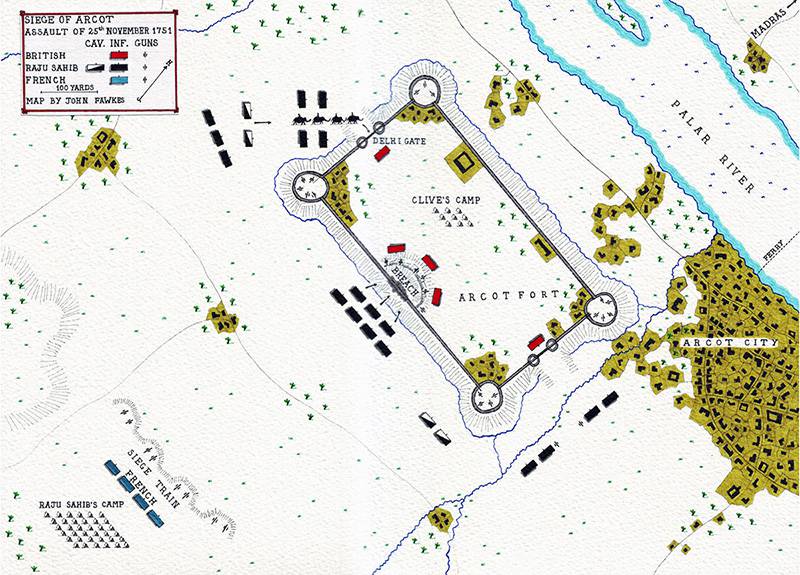
Sahib enthusiastically pecked on a simple trick - the prospect of losing his own palace with all the good was an essential argument. He sent his relative Rez Sahib to Arcot along with 4 thousands of warriors and 150 French. September 23 this army has already approached the city. Clive gave the enemy a battle in narrow and barricaded streets, where many French were killed, and then, having very limited strength, did not play at the Duke of Marlborough and took refuge in the citadel, which Reza Sahib began to besiege. The siege was lengthy: French guns arrived from Pondicherry along with calculations and began to regularly bombard Clive’s positions, but he did not give up and made forays. Soon, the besiegers began rumors that the Maratha rajah was coming to the aid of the British with almost 6 thousands of warriors, and this news forced Reza Sahib to take a decisive assault on 24 in November, which was successfully repulsed. After the 50 day siege, the Indians and the French collapsed and retreated. Victory at Arcot highly raised the prestige of England and Clive himself. The local rajas and princes strongly thought about which of the newcomers is stronger, ruthless and successful. And so far, the British maintained a confident primacy. In 1752, Chanda Sahib died suddenly, and Mohammed Ali took his place unhindered. It should be noted that in Europe at this time between France and England, there was formally peace.
Bengali crisis
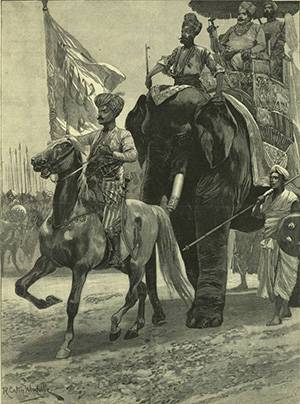
The positions of the British East India Company have been steadily growing, although the competition with the French was more like neutrality armed to the teeth. Not everything was simple and in relations with the local Indian nobility, whose moods were far from constant. In 1756, the situation in Bengal became tense. Previously, the British could trade there without difficulty, but the new nabob Siraj-ud-Daul decided to make some amendments. Having received information about the very large profits of British and other European trading companies, enriched literally under his nose, not paying any taxes on it, the ruler of Bengal lost peace of mind and began to carry out plans to bring malicious defaulters to justice.
Business people, who came to the news of some concern about the number of their incomes, also began to worry and forts and trading posts were strengthened from harm. And it was done not only by the British, but also by the French. Siraj-ud-Daul was alarmed: not only did the Europeans collect generous profits in his country, they also dared to build fortifications that could be used for military operations. Nabob demanded to stop the unauthorized fortification. The French, grumbling, agreed, but the British, whose economic positions in Bengal were more durable, refused to weaken their fortifications in Calcutta. Gentlemen sincerely believed that where the flag of St. George flies, there is no place for any pathetic claims of local princes, even if it is their local land.
Seeing the persistence of the British, Siraj-ud-Daul decided to clarify the differences that arose. At the head of a strong military detachment, he approached Calcutta, surrounded the British-owned Fort William, and demanded his surrender. After a two-day siege, the trading post surrendered. All Europeans were arrested and put in a local prison. It was a hot tropical summer, and on the nearest night, some of the prisoners, who were densely concentrated in a cramped room, died from suffocation and heat strokes. For Hindus, this practice of detention was the norm, but they did not calculate that for Europeans the local climate is much less comfortable. It is likely that the nabob were not even informed of the conditions under which the captured British were placed. However story had a very rapid continuation. 16 August 1756 The news of the actual expulsion of the British from Calcutta in highly ornamented form reached Madras. The local leadership, choking on heat and anger, decided to restore the colonial order in the company’s territory and explain to local ignorant people how expensive and, most importantly, dangerous to offend noble gentlemen. For training in the subtleties of good manners, 600 armed Europeans from among the own forces of the East India Company, three companies of army infantry and 900 sepoys were involved. The expedition was led by Robert Clive, a caretaker after Arkot's Victoria, recently returned from England. Boarded the ships, the British began their trip. 2 January 1757. They came along the Hugli River (one of the tributaries of the Ganges) to Calcutta. Landing was made, the Indian garrison at the approach of the British quickly escaped.
It was not practical for the British to regain their positions in Bengal - the local ruler, with his completely outrageous attempts to control the local East India business, was a nuisance to them. Clive was strengthened and put in order the fortifications of Calcutta and Fort William. Siraj, in the meantime, calmed down a bit and offered the British a compromise solution to the problem: to keep their trade intact in exchange for the change of the local English governor. However, the concentration of the army under his command in almost 40. Thousands of people gave him confidence, and the nabob fully armed approached Calcutta. 5 February 1757, when it became apparent that the negotiation phase was over, Clive decided to attack first. With more 500 infantry and artillerymen, about 600 armed sailors from ship crews, almost 900 seapays, the British commander attacked the enemy camp. An attempt to counterattack the Indian cavalry ended in failure, the nabob troops were upset, but the coming dense fog prevented Clive from developing success, and he was forced to retreat to the starting positions.
This not-so-successful venture nevertheless impressed Siraj, and he again spoke of the granting of trade privileges to the East India Company. To heighten peace, he ordered his army to withdraw from Calcutta. While both leaders were competing with each other in the fine art of weaving intrigue and seeking benefits where it does not appear at first glance, the Seven Years' War, which had already broken out in Europe, had reached even a distant Hindustan. Intensified French, seeking to fully benefit from the Anglo-Bengali conflict. Emissaries of French companies and government agencies were engaged in campaigning among local nobility, calling for the “greedy Englishmen” to be driven away. As far as the “generous French people” were subject to this annoying vice, emissaries modestly kept silent. In an effort to limit the activity of competitors, Clive seized the city of Chandannagar, located in 32 km north of Calcutta, which is a French stronghold.
Conspiracy
Robert Clive soon came to the obvious conclusion that the problem that had arisen in Bengal had to be solved fundamentally, that is, to expel the French, and then to deal with the local people. All attempts to convince the Nabob that it is necessary to do something with the French have failed. Siraj was not at all stupid and clearly saw the advantage of his position during the conflict of the white aliens. Nabob diligently tried to maintain an acceptable relationship with both parties. The situation hung in the air. And then Clive received information that not everything is so simple in the company of Siraj himself. The ruler of Bengal came to power through the choice of the previous nabob, his grandfather, who appointed him as his successor, bypassing several other older relatives. And these relatives were not at all filled with joy from such a choice. Discontent took shape in a conspiracy centered on Nabob's uncle, Mir Jafar, who held a very useful position as treasurer of the entire army. The British and the conspirators soon made contact: Clive began a perilous game and promised Mir Jafar all possible assistance in getting rid of his nephew who did not share "European values". In anticipation of the coup, British troops were put on alert, and to speed up the process, Clive wrote a sharp letter to Siraj, threatening war. The calculation was made on the fact that the nabob would be forced to give a battle, during which an accelerated procedure for removal from office would be performed.
Plessis
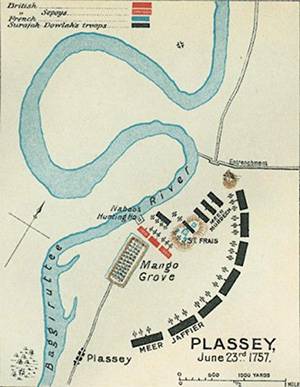
12 Jun. Clive, who had lodged in Chandannagar, repulsed by the French, was finally able to make a move north - a reinforcement from Calcutta came up. He had more than 600 European soldiers, 170 artillerymen serving 10 field guns, and 2200 sipahs and other armed natives. Already on the march, Clive received new details of the passions that were seething at the court of the nabob. It turned out that, on the one hand, Siraj tried to negotiate with the "opposition", and on the other, it was not known whether the parties had reached a compromise and what was the position of Uncle Mir Jafar. Only then it turned out that he firmly decided to overthrow his nephew and negotiated with him, only to put down his guard.
Clive gathered his officers to the military council with a proposal to consider a further plan of action. Most were in favor of stopping the operation and retreat to Calcutta - according to the available information, the enemy had from 40 to 50 thousands of people and several dozen guns. Nevertheless, despite the results of the vote, Clive gave the order to prepare for the march. 22 June 1757, his army approached the village of Plessis. The British have equipped their positions among the mango grove, surrounded by a clay wall and a moat. In the center was a hunting lodge, in which Clive equipped his headquarters. Siraj had lodged with the whole army for several days in a fortified camp in Plessis. The data on the number of his troops differ - one can confidently say that at the disposal of the nabob there were at least 35 thousand people (20 thousand infantry and 15 thousand cavalry) armed with a wide nomenclature of the most diverse weapons: from wick guns to swords and bows. The artillery park consisted of 55 guns. The battle was also attended by a small French contingent under the command of Chevalier Saint-Freza: about 50 people, mostly gunners, had four light field guns. These Frenchmen managed to escape from the Chandannagar taken by the British, and they were determined to take revenge. The positions of the nabob were located near the Hugli River and were equipped with earthworks. The opposing sides were divided by flat terrain with several artificial ponds.
At dawn on 23 June, the Siraj forces began advancing towards the manga grove, where the British positions were. Indians transported their guns on large wooden platforms, which dragged oxen. The British were impressed by the number of enemy troops that flooded the entire valley. The column, led by Mir Jafar, dangerously swept the English right flank. Clive, who still did not know about the position of the main "oppositionist," wrote a letter to him demanding a meeting, otherwise threatening to make peace with the nabob.
However, the battle has already begun. At 8 in the morning, the French guns of Saint-Freza opened fire on the British, and soon all the Indian artillery joined them. Having lost a few dozen people, the British took refuge in a grove. Their opponents, mistakenly believing that Clive’s troops were retreating, came closer and immediately began to suffer from well-aimed English rifle and artillery fire. The cannon duel lasted for several hours, but the fire of the Indians was unaffected and caused more damage to the mango trees. Peace Jafar did not get in touch, and Clive decided to defend himself in his comfortable positions until nightfall, and then retreat.
However, the weather interfered in the course of the battle - a tropical downpour began. Hindus preferred to keep gunpowder open and soon he was thoroughly wet. The British also sheltered their ammunition with tarred canvas, therefore, when the rain subsided, the firing advantage firmly moved to Clive's troops. Nabob, a devoted commander Mir Madan, attempted to organize a massive cavalry attack on the British, but at the very beginning was smitten with a canister, and this idea ended in failure. Soon, the nabob was informed that another commander, loyal to him, Bagadur al-Khan, son-in-law of Siraj, was mortally wounded. At this moment, only the cavalry of Mir Madana and the French were engaged in active hostilities, and almost two thirds of the Indian army simply stagnated. Surrounded by the conspirators nabob hurried messengers with the "correct" reports, the essence of which boiled down to the fact that everything is bad and it would be time to flee. Good uncle strongly advised Siraj to leave the army and retreat to the capital, the city of Murshidabad. In the end, the nabob broke down and, accompanied by 2, a thousand of its guards left the battlefield. Control over the army completely moved to the "opposition".
The fact that something was happening on the other side did not elude the British’s view: a part of the Indian forces began to retreat to the camp, the Peace Jafar contingent did not take any active actions at all. The fiercest resistance was provided by the French, methodically leading fire from their guns. They retreated last, taking new positions already on the earthworks of the Indian camp and re-opening fire. Saint-Frez did not understand the reasons for the sudden and irregular retreat of the nabob troops and demanded a massive counterattack from their allies. With the support of few but effective French artillery, she would have had a great chance of success, but the Hindu commanders involved in the plot simply ignored Saint-Frez's appeals. While this verbal skirmish was taking place, Clive, having made sure that the column that threatened his right flank belonged to Mir Jafar and did nothing, ordered to attack along the entire line. The Indian camp was subjected to intensive shelling, and there soon began a panic, although the nabob troops still exerted elemental resistance. Numerous arrows fired from wick guns at the advancing British, the soldiers of Saint-Freza did not leave their positions. However, by that time the general leadership of the troops was lost, and they began to leave the camp in a hurry and disorder. The French kept to the last, while under the threat of encirclement they were not forced to leave their guns and retreat. By five o'clock in the evening the camp was taken. The British got a huge booty, a lot of pack animals, including elephants, and all the artillery. Clive was finally delivered a message from Mir Jafar with all sorts of expressions of loyalty. His contingent, which occupied the most threatening positions for the British, did not take any part in the battle.
The battle at Plessis cost the Anglo-Indian troops in the 22 man killed and about 50 wounded. The loss of Nabob's army Clive estimated at about 500 people. The success of Clive was difficult to overestimate - in fact, this event brought the British under control of the whole of Bengal and dealt a serious, even fatal blow to the French position in the region. Soon, Clive publicly confirmed the authority of Mir Jafar as the new nabob of Bengal. Without any support, Siraj fled to his relative, who was Mir Jafar's sibling. Soon the overthrown ruler was simply stabbed to death, and the corpse was put on public display. Mir Jafar, who was in power, tried to tack again, flirting now with the Dutch. The English administration was fed up with such a multi-vector nature of its protégé, and Jafar was surrounded by numerous English advisers and consultants. He died in the 1765 year, deprived of any support from his subjects. After him, the independence of Bengal wore only a formal and decorative character.
After the Plessey, the English and Frenchmen, with varying success, repeatedly crossed swords in the vastness of Hindustan, and in 1761 of Pondicherry, the main stronghold of the Golden Lilies in India was stormed. Since then, no one has challenged English domination in these lands. According to the Paris Peace Treaty, which ended the Seven Years War, France lost the lion’s share of its colonies: Canada, a number of islands in the Caribbean, and French India were lost. The few French enclaves continued to exist in Hindustan, but they no longer played any decisive role.
Information